As prices for DDR5 decline, which have fallen by more than one and a half times over the past 18 months, questions are increasingly arising about memory kits with increased capacity. Although the unspoken standard for modern above-average systems has become the use of 32 GB of memory, more and more users are asking the price of 48 or 64 GB kits, which are available in abundance on store shelves. They are driven by two considerations. Firstly, purchasing a DDR5 kit with increased capacity seems to them to be a good foundation for the future, since the general trend is that new games and applications are gradually increasing their appetites for the required amount of memory. And secondly, there is an opinion that increasing the amount of memory has a positive effect on system performance.
The problem is that both of these arguments can be questioned. As for the amount of memory actually needed for work, there are undoubtedly tasks in nature that require as much RAM as possible to solve, and 32 GB will clearly not be enough. Working on high-resolution content (2D and 3D graphics or video editing), developing complex software, training AI models, and similar tasks can indeed require a lot of RAM. But all of these are rather exceptions, affecting a rather narrow contingent of PC users. As for commonly used applications and games, 32 GB is enough for them with a good margin. Moreover, you can often get by with 16 GB of memory without any problems – for many programs and games this is enough, especially if the system has a graphics card with 12+ GB of video memory. In such conditions, purchasing DDR5 kits with a capacity of more than 32 GB is a rather dubious investment in the future, since by the time such an amount of memory may actually become necessary, completely different platforms with support for DDR6 or some other promising standards will already be in use.
The impact of memory size on performance is also quite ambiguous. On the one hand, we all remember well that in platforms with DDR4 support, the transition from 16 to 32 GB kits actually had a positive impact on performance due to the dual-ranking of 16 GB DDR4 modules. A similar effect is observed when comparing the performance of DDR5 kits with a total capacity of 16 and 32 GB, but not due to dual-rank (which DDR5 modules and 8 and 16 GB do not have), but due to the artificially reduced number of memory banks in 8 GB sticks DDR5. However, on the other hand, 32- and 48-GB DDR5 kits offer completely identical performance, since both 16-GB and 24-GB modules do not differ in internal organization and have a peer-to-peer design. Thus, the capacity of DDR5 modules does not always affect performance. But DDR5 kits with a total capacity of 64 GB, which consist of 32 GB modules, should still differ in performance. These modules, unlike less capacious ones, are already two-rank, and therefore the memory subsystem assembled on their basis receives a higher degree of parallelism. This means that, by analogy with sets of dual-rank DDR4 modules, 64 GB DDR5 sets should provide increased performance compared to sets of smaller volumes simply due to their structure.
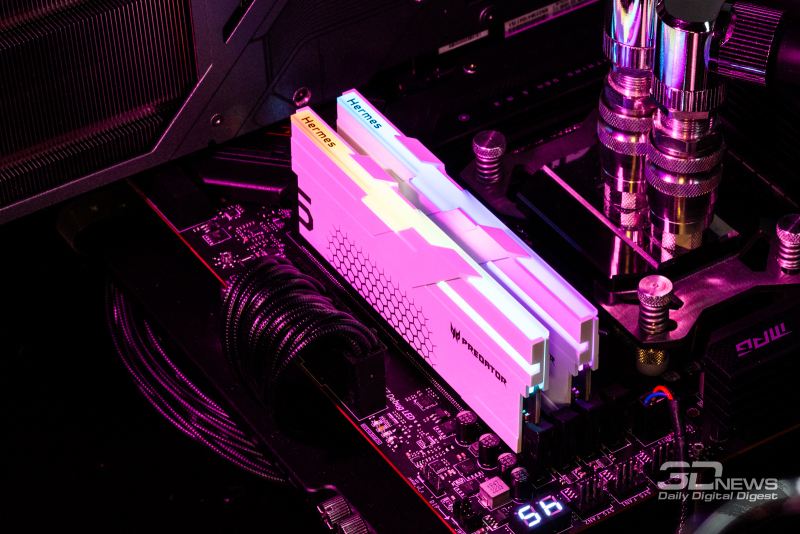
But this hypothesis needs practical testing. DDR5 is very different from DDR4 in architecture, and therefore it would be incorrect to transfer observations made earlier to new memory. The fact is that each DDR5 module, unlike DDR4 modules with a 64-bit bus, is divided into two independent 32-bit subchannels. And therefore, DDR5 memory, unlike DDR4, has a higher level of parallelism initially, and therefore the effect of adding ranks to the memory subsystem formula may not play a significant role.
To study this issue in more detail, we received an Acer Predator Hermes RGB DDR5-6400 kit, consisting of two 32 GB modules. The big advantage of this memory is that it is assembled on selected SK Hynix chips, which are also used in the most popular 32 GB sets among enthusiasts. Such homogeneity of the element base will allow us to make a head-to-head comparison and check two things at once. Firstly: is it possible to use the same aggressive timings with dual-rank 32 GB DDR5 modules, which significantly load the memory controller more, as in the case of the usual single-rank 16 GB models? And secondly: will a system with 64 GB of DDR5 really be faster than a similar configuration with 32 GB of memory?
We have already carried out similar testing using the LGA1700 platform as a testing ground, and the results obtained then turned out to be quite ambiguous and did not allow us to give clear answers to the questions posed. Therefore, today we will conduct testing on the alternative Socket AM5 platform with the Ryzen 7 7800X3D processor, which is rightfully considered the best choice for gaming configurations. And this is a completely different test, since the memory controller in Ryzen has a fundamentally different design. Compared to the memory controller of Intel processors, for which memory speed is of paramount importance, it is much more sensitive to latency. Therefore, the result of today’s testing may turn out to be completely different and at the same time much more revealing.
⇡#Modules Acer Predator Hermes RGB DDR5-6400 2×32 GB
Perhaps we should start with the fact that Acer Predator memory modules have a rather indirect relationship with Acer. Although this sounds rather strange, this Taiwanese company does not actually manufacture, design or even sell them. Back in 2021, it leased its trademark to the Chinese manufacturer Biwin, which now produces and distributes memory and solid-state drives under the name Acer Predator. And it’s actually not that bad. Biwin is a fairly large player in the memory market, which has long gained a positive reputation through many years of cooperation with HP, under whose brand it also produces and sells memory and solid-state drives.
Biwin has filled the Acer Predator family of overclocking DDR5 modules with three types of products. The Pallas II series are the simplest modules with radiators without RGB backlighting and with a maximum frequency of 6600 MHz, the Vesta II series includes modules with RGB backlighting and modes up to DDR5-7200, and the oldest Hermes series is distinguished by its increased (and height, and thickness) radiators, a wide variety of high-speed modifications and support for frequencies up to 8000 MHz.
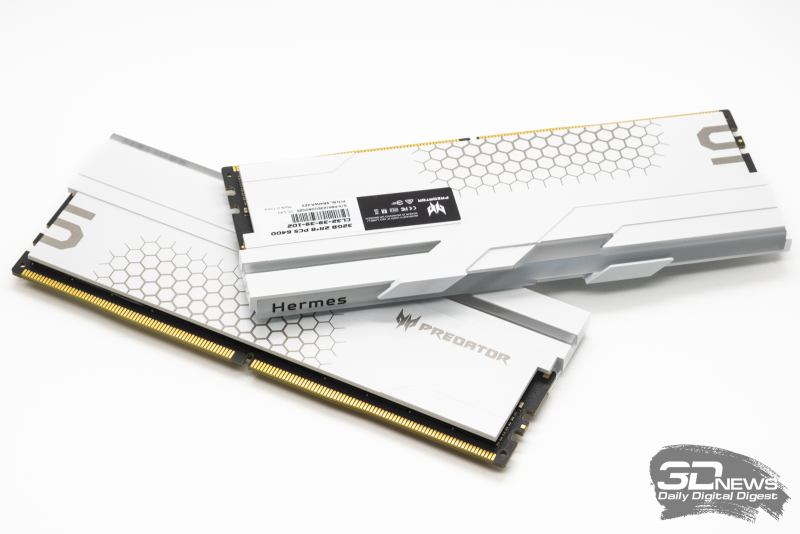
In fact, we received the slowest version of the Acer Predator Hermes RGB DDR5 for testing: its passport mode is DDR5-6400. However, there is an important nuance: we are talking about a 64 GB memory kit, and there are simply no faster versions of DDR5 modules with such a capacity (in parentheses, we note that some manufacturers still offer 64 GB DDR5-6800 kits, but this is an exception , only confirming the rule). The thing is that dual-rank modules with a capacity of 32 GB are essentially “two modules in one” and load the processor’s memory controller much more than 16 or 24 GB modules. Therefore, in the end, the processor itself does not pull higher frequencies, no matter whether we are talking about AMD Ryzen or Intel Core in this case. In other words, the DDR5-6400 mode is a basic hardware limitation for 64 GB kits, which is still very difficult to overcome.
The Acer Predator Hermes RGB DDR5-6400 2×32 GB kit looks very impressive. The manufacturer produces this memory with radiators in black, silver and white. We received the latest version for testing, which has now become very fashionable. But what makes a stronger impression is not the color, but the monumentality of these modules. Their radiators are not only very tall – 48 mm in height, but also thick – about 1.9 mm in thickness. As a result, the memory turned out to be large – the height of the assembled module reaches 52 mm – and weighty – each strip weighs almost 100 grams.
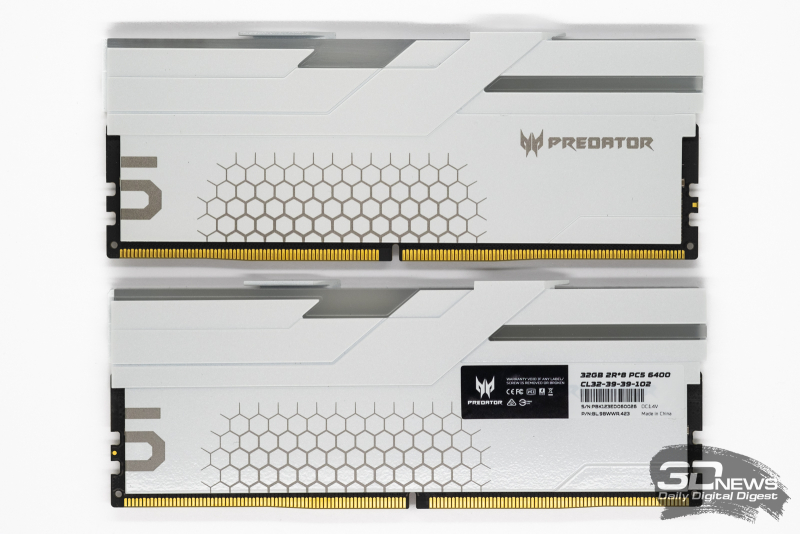
All the additional space in the upper part of the modules is occupied by an RGB backlight light diffuser, which is figuratively inscribed in the top one and a half centimeters of the radiators. In addition, the surfaces of the radiators are decorated with a large number 5 and a “honeycomb” pattern. All this looks quite appropriate, and the appearance of the memory in question remains quite austere.
Each module has a label on it explaining what kind of memory it is. It contains information not only about the frequency and capacity of the modules, but also about their passport timings and voltage. The organization is also described: 2R*8 means that the module is two-rank and eight chips are soldered on each side.
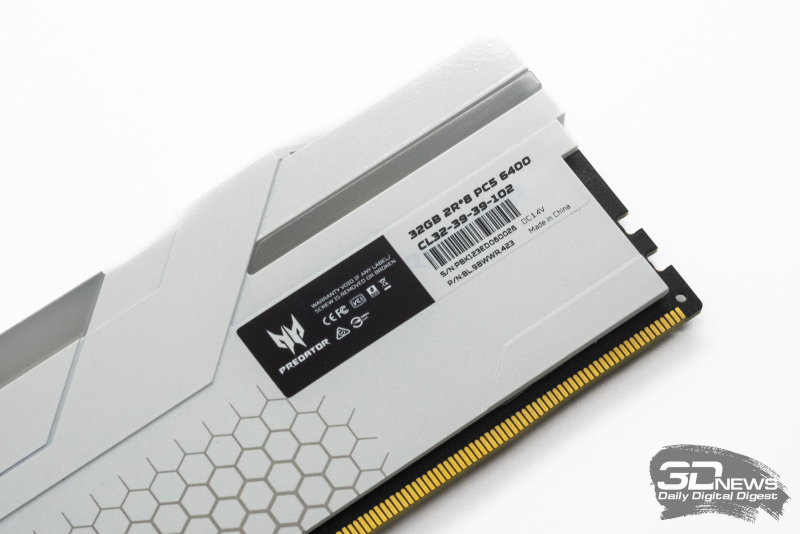
Memory specifications are not only fixed on a sticker, but also embedded in the XMP profile (modules do not have a separate EXPO profile). It contains the same delays and voltages as on the label.
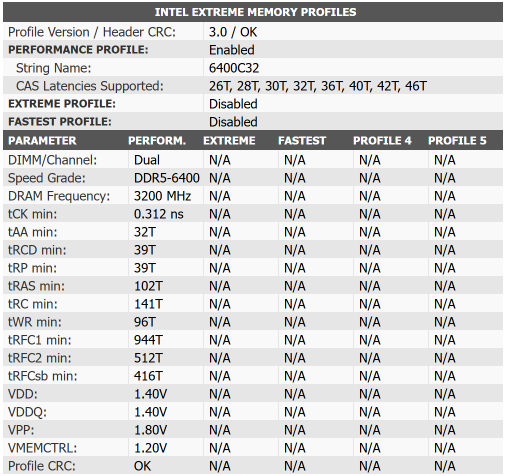
Thus, the full formal specification of the Acer Predator Hermes RGB DDR5-6400 2×32 GB with article number BL.9BWWR.423 is as follows:
- Set of two DDR5 DIMM modules, 32 GB each;
- Operating mode DDR5-6400;
- Timing 32-39-39-102;
- Voltage 1.4 V;
- XMP 3.0 support;
- RGB backlight;
- Tall white heat dissipators;
- Lifetime warranty.
To get acquainted with the hardware basis of the modules in question, radiators were removed from them. This is not too difficult to do – they are attached with ordinary heat-conducting double-sided tape.
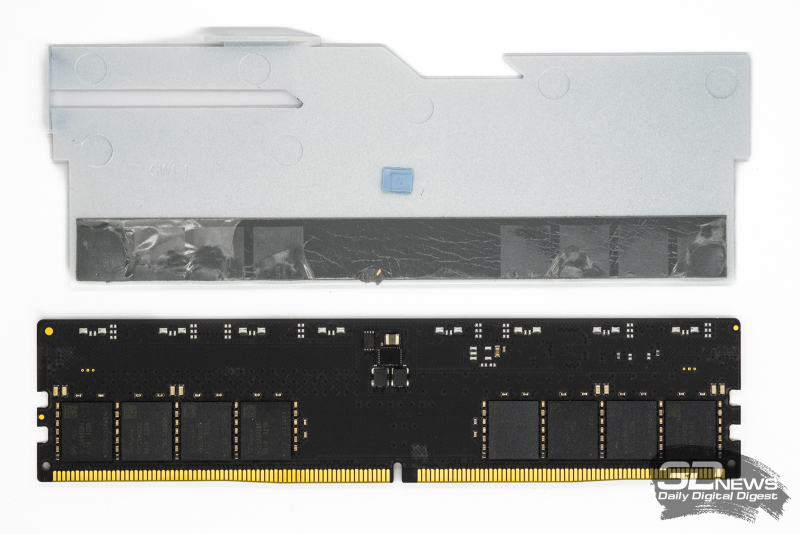
Inside is a printed circuit board with sixteen memory chips with a capacity of 16 Gbit produced by SK Hynix, located on both sides. Moreover, these chips belong to the A-die class, that is, among the most overclockable, which is easy to find out by their marking H5CG48AGBD-X018. And this is quite atypical: usually M-die chips are installed in 32 GB modules, since they are obviously not required to operate at frequencies above 6400 MHz. But Biwin considers Acer Predator Hermes kits to be a premium product, so it chose the best hardware at the moment.
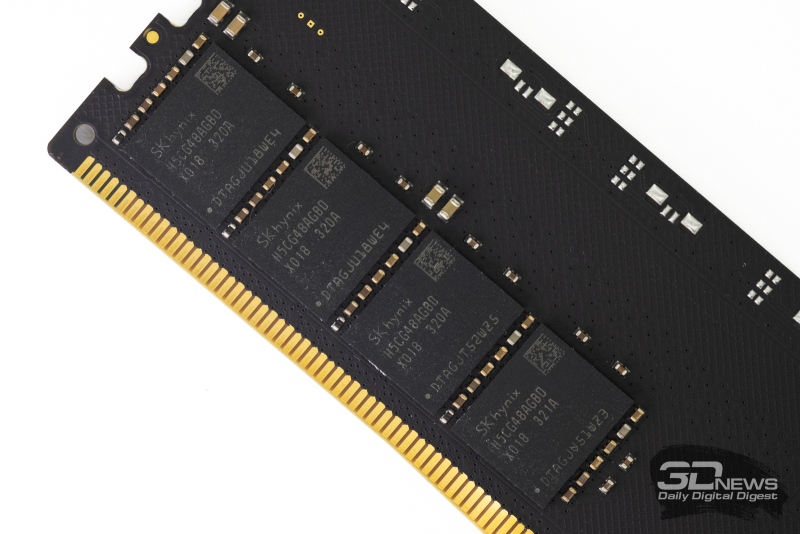
The power supply circuit of the Acer Predator Hermes RGB module is assembled on a Richtek integrated circuit, and the manufacturer did not skimp on a thermal pad to cool it. Also on the printed circuit board are eight RGB LEDs, which for some reason are located only on one side of the module. You can control their glow through standard utilities supplied with motherboards from various manufacturers.
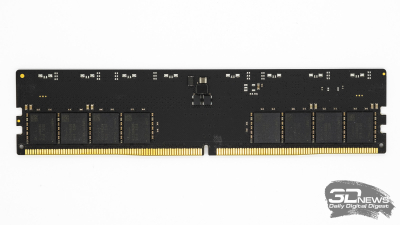
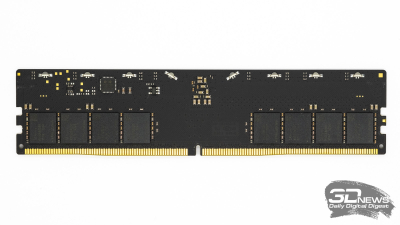
It is quite curious that the dimensions of the modules of the Acer Predator Hermes RGB DDR5-6400 2×32 GB kit are not at all related to their circuit design. The printed circuit board used in them is of a completely standard size for backlit memory. And the increased height is determined solely by the size of the radiator. But there’s no point in complaining about this, although the Acer Predator Hermes RGB modules simply won’t fit into some assemblies. But larger radiators provide better cooling of the chips, and in this case this is appropriate, since the heat dissipation of 32 GB modules is significantly higher than that of 16 GB modules. However, you need to keep in mind that the Acer Predator Hermes RGB memory will conflict with dual-tower air coolers and will definitely not fit in compact systems.
⇡#Operation in nominal mode
There is no point in using any modern overclocking memory with default settings. So, for example, the Acer Predator Hermes RGB DDR5-6400 2×32 GB kit in question, if you do not make any changes to the BIOS settings, will launch in “compatibility” mode – DDR5-5200 with timings 42-42-42-84, taken from SPD . It is curious that the SPD also contains a settings option for a faster DDR5-5600 mode, but Socket AM5 boards have not yet decided to use it, because the Ryzen 7000 series processors (unlike the next generation Ryzen 9000) officially support only DDR5-5200.
Why the automatic settings are bad should be clear from the screenshot below of the Aida64 Cachemem benchmark: the practical throughput turns out to be too low, and the latency is too high. And most importantly, the potential of the modules in this mode is not revealed at all – they are clearly capable of more.
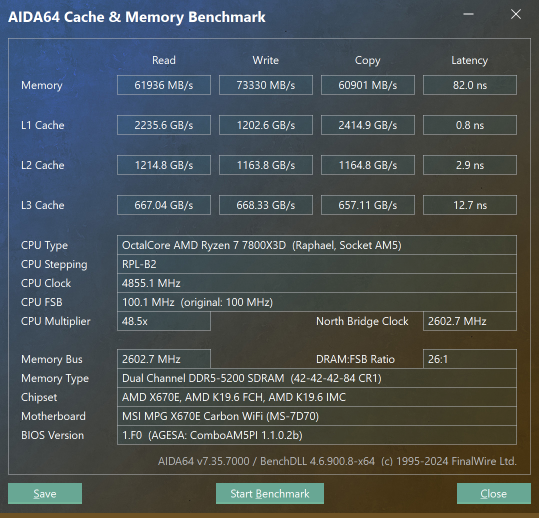
Simply applying an XMP profile can dramatically improve your performance in one click. After its activation, the DDR5-6400 mode required for the models in question will be activated with a more aggressive timing scheme – 32-39-39-102. With these settings, the practical performance indicators of the memory subsystem look significantly better – the speed of writing to memory increases by 20%, and latency drops by 13%.
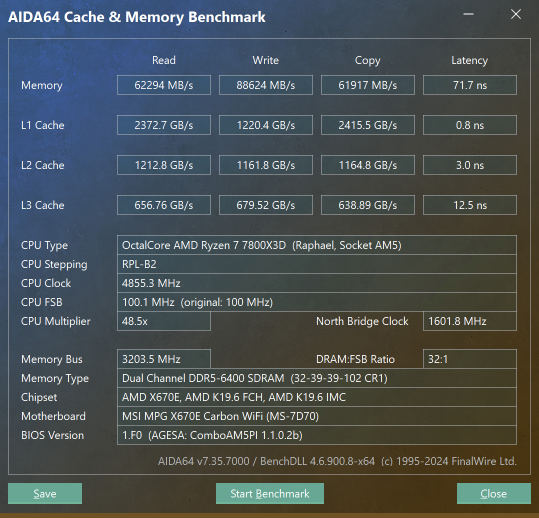
However, it is important to remember that Ryzen 7000 processors, when working with DDR5-6400, automatically reduce the frequency of their own memory controller, switching it from synchronous to 1:2 mode. Therefore, when using the XMP profile for the Acer Predator Hermes RGB DDR5-6400 2×32 GB kit, you then need to manually switch the memory controller back to synchronous mode. Most processors can work with this kind of memory without any problems. And in this case, the memory subsystem will function even more efficiently. This can be seen from the additional increase in performance in Aida64 Cachemem.
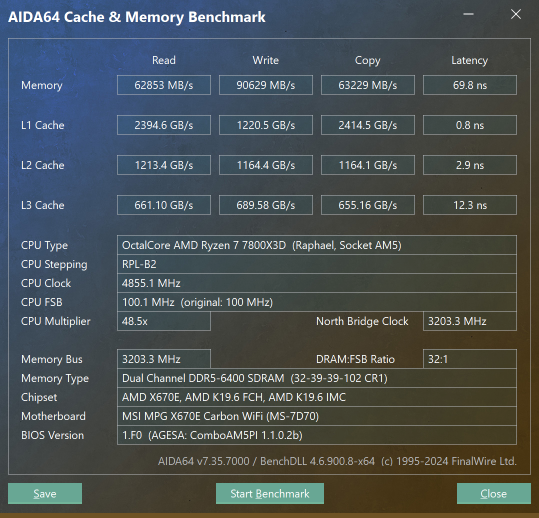
⇡#Setting timings
DDR5-6400 is considered ideal for Ryzen 7000-based systems, as it is the highest frequency at which the memory controller of these processors can operate in synchronous mode. Therefore, it makes no sense to overclock the Acer Predator Hermes RGB DDR5-6400 2×32 GB kit in the Socket AM5 platform. And it’s unlikely to work, because we are talking about dual-rank modules, with which the memory controllers of modern processors work quite strained.
But no one bothers you to adjust the timings, which in systems based on Ryzen 7000 usually gives a significant increase in performance. And the good news is that dual-rank 32GB memory modules can handle aggressive latency just as well as their 16GB counterparts. Especially when we are talking about such high-quality memory as the Acer Predator Hermes RGB DDR5-6400 2×32 GB, which is built on first-class SK Hynix A-die chips.
In fact, for the kit under consideration, the same timing scheme is applicable, which is recommended for 2×16 GB kits based on SK Hynix A-die chips with minimal adjustments.
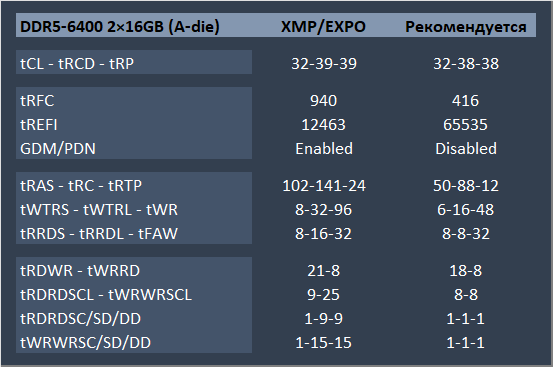
As a practical test has shown, only two amendments need to be made to the scheme recommended for 32 GB kits (see memo above). Firstly, dual-rank modules cannot work with the Gear Down Mode setting disabled, so it must be left in the Enabled state. This setting introduces an additional one-cycle delay when switching chips, which is vital for dual-rank modules with 16 chips. And secondly, it becomes impossible to use single values for the tRDRDSD and tWRWRSD timings, since they control the delays between successive read and write operations within the same DIMM. Since in the case of two-rank modules such operations can belong to different ranks, these timings have to be increased to 6-8 clock cycles.
Otherwise, the Acer Predator Hermes RGB DDR5-6400 2×32 GB kit is capable of operating with the same latency scheme as the popular 2×16 GB kits. And after optimizing the timings, its settings look like this.
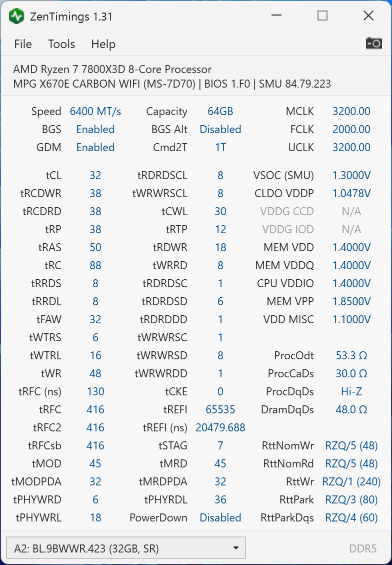
The significant change in settings compared to the timings from XMP, naturally, cannot but affect the performance of the memory subsystem. It has a particularly noticeable effect on practical latency – optimization can reduce it by an additional 13%.
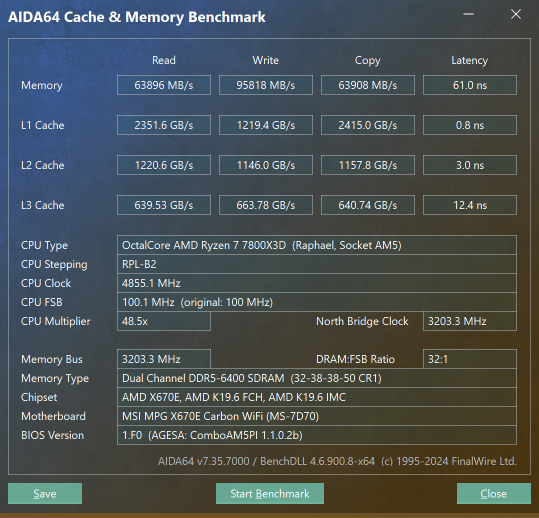
And after this setup, it’s time to make sure that the Acer Predator Hermes RGB DDR5-6400 2×32 GB kit has everything in order with cooling. Indeed, despite its increased capacity and power consumption of 6 W per module, massive heat dissipators keep their temperature within reasonable limits.
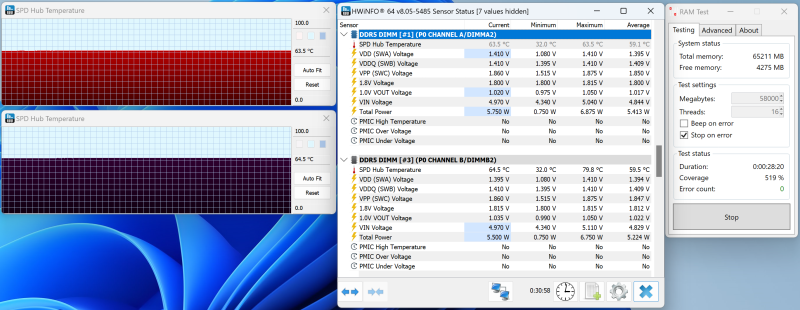
Even after compressing all the timings, it does not rise above 65 degrees in stability tests, although in our test system no additional airflow was used for the memory.
⇡#Description of the test system and testing methodology
As a result, we ended up with a 2×32 GB kit, made up of dual-rank modules and at the same time capable of working in a Socket AM5 system with almost the same settings as the more familiar 2×16 GB DDR5 memory on SK Hynix A-die chips. And this is an excellent opportunity to compare such memory configuration options to determine whether dual-rank provides any performance advantage in itself and whether it makes sense to buy more capacious sets for the sake of performance gains.
To conduct such testing, in addition to the Acer Predator Hermes RGB DDR5-6400 2×32 GB kit described above, we took a popular 32 GB kit with 16 GB peer-to-peer modules – Adata XPG Lancer Blade DDR5-6400 2×16 GB. It is also built on SK Hynix A-die chips and is designed to work with a timing scheme of 32-39-39-89. As a result, we will compare the performance of peer-to-peer and dual-peer modules twice – when choosing timing settings from the XMP (EXPO) profile and when setting them manually.
Ultimately, the test systems included the following set of components.
- Processor: AMD Ryzen 7 7800X3D (Raphael, 8 cores, 4.2-5.0 GHz, 96 MB L3).
- CPU cooler: custom liquid cooling system made from EKWB components.
- Motherboard: MSI MPG X670E Carbon WiFi (AM5 Socket, AMD X670E).
-
- Acer Predator Hermes RGB DDR5 64GB 6400MHz HERMES-64GB-6400-2R8-V1 (2 × 32 Гбайт DDR5-6400 SDRAM);
- Adata XPG Lancer Blade RGB DDR5 32GB 6400MHz AX5U6400C3216G-DTLABBK (2 × 16 Гбайт DDR5-6400 SDRAM).
- Video card: GIGABYTE GeForce RTX 4090 Gaming OC (AD102 2235/2535 MHz, 24 GB GDDR6X 21 Gbps).
- Disk subsystem: Intel SSD 760p 2 TB (SSDPEKKW020T8X1).
- Power supply: ASUS ROG-THOR-1200P (80 Plus Titanium, 1200 W).
Testing was performed on the Microsoft Windows 11 Pro (22H2) Build 22621.1555 operating system using the following set of drivers:
- AMD Chipset Driver 6.05.28.016;
- NVIDIA GeForce 546.01 Driver.
The following tools were used to measure computing performance:
Synthetic benchmarks:
- AIDA64 Engineer 7.35.7000 – test of the Cache and Memory Benchmark memory subsystem.
- Geekbench 6.2.2 measures single-threaded and multi-threaded CPU performance in typical user scenarios, from reading email to image processing.
Tests in applications:
- 7-zip 23.01 — compression and decompression speed testing. Built-in benchmark with dictionary size up to 64 MB is used.
- Adobe Photoshop 2023 24.7.1 — testing performance when processing graphic images. The PugetBench for Photoshop V0.93.7 test script is used, simulating basic operations and working with the Camera Raw Filter, Lens Correction, Reduce Noise, Smart Sharpen, Field Blur, Tilt-Shift Blur, Iris Blur, Adaptive Wide Angle, Liquify filters.
- Adobe Photoshop Lightroom Classic 12.5 — testing performance in batch processing of a series of RAW images. The PugetBench for Lightroom Classic V0.95 test script is used, simulating basic work with the library and editing, as well as import/export, Smart Preview, creation of panoramas and HDR images.
- Adobe Premiere Pro 2023 23.6.0 — testing video editing performance. The PugetBench for Premiere Pro V0.98 test script is used, simulating editing 4K videos in different formats, applying various effects to them, and the final rendering for YouTube.
- Blender 4.0 — testing the speed of final rendering on CPU. The standard Blender Benchmark is used.
- Cinebench 2024 is a standard benchmark for testing rendering speed in Cinema 4D 2024.
- Microsoft Visual Studio 2022 (17.8.0) – Measuring the compilation time of a large MSVC project – Blender version 4.0.
Games:
- Baldur’s Gate 3. Graphics settings: Vulcan, Overall Preset = Ultra.
- Cities: Skylines II. Настройки графики: Global Graphics Quality = High, Anti-aliasing Quality = Low SMAA, Volumetrics Quality Settings = Disabled, Depth of Field Quality = Disabled, Level of Detail = Low.
- Cyberpunk 2077 2.01. Graphics settings: Quick Preset = RayTracing: Medium.
- Hitman 3. Настройки графики: Super Sampling = 1.0, Level of Detail = Ultra, Texture Quality = High, Texture Filter = Anisotropic 16x, SSAO = Ultra, Shadow Quality = Ultra, Mirrors Reflection Quality = High, SSR Quality = High, Variable Rate Shading = Quality.
- Marvel’s Spider-Man Remastered. Настройки графики: Preset = Very High, Ray-Traced reflection = On, Reflection Resolution = Very High, Geometry Detail = Very High, Object Range = 10, Anti-Aliasing = TAA.
- Shadow of the Tomb Raider. Настройки графики: DirectX12, Preset = Highest, Anti-Aliasing = TAA, Ray Traced Shadow Quality = Ultra.
- Starfield. Graphics settings: Graphics Preset = Ultra, Upscaling = Off.
- The Witcher 3: Wild Hunt 4.04. Graphics settings: Graphics Preset = RT Ultra.
In all game tests, the average number of frames per second, as well as 0.01-quantile (first percentile) for FPS values are given as results. The use of 0.01-quantile instead of the minimum FPS is due to the desire to clear the results from random bursts of performance that were provoked by reasons not directly related to the operation of the main components of the platform.
⇡#Performance
Above we showed the performance of the Acer Predator Hermes RGB DDR5-6400 2×32 GB kit according to the synthetic benchmark Aida64 Cachemem with passport timings configured using XMP and with its manual settings. Let’s now compare these results with the indicators that can be obtained if we use the Adata XPG Lancer Blade DDR5-6400 2×16 GB kit in the same system, that is, peer-to-peer modules with half the capacity.




At first glance, single-rank and dual-rank modules provide fairly similar memory subsystem performance. However, there is still a difference – the Acer Predator Hermes RGB kit, consisting of 32 GB modules, works a little faster, and this difference is most pronounced when configuring the memory subsystem via XMP, when peer modules do not take advantage of their ability to work with Gear Down Mode turned off . However, in platforms with DDR4 memory, dual-rank modules made it possible to obtain a more tangible advantage in any case. It turns out that the dual-ranking of modules in the case of DDR5 actually affects the performance of the memory subsystem to a lesser extent than it did before. But let’s not draw hasty conclusions and let’s see how the 2×32 GB kit performs in applications and games.
In the Geekbench integral benchmark, which evaluates performance using algorithms from real applications, the difference between 2×16 GB and 2×32 GB memory kits also looks homeopathic and, in the best case, does not exceed 1%.


Approximately the same situation is observed in real resource-intensive applications. True, when archiving and in Photoshop, the 2×32 GB kit speeds up the system by almost 2%, but only if you compare the results with nominal settings for XMP. If you pull out the timings manually, then the gap between peer-to-peer and two-rank modules is reduced to ephemeral values.









But in games, things tend to be a little different. Actually, for the sake of games, you need to strive to improve memory characteristics – they react to the speed of RAM much more sensitively than the vast majority of resource-intensive applications. But even in this case, changing the DDR5 2×16 GB kit to 2×32 GB can improve FPS (in Full HD resolution) by only 1-2%. And this, of course, is a very small increase against the backdrop of a twofold increase in the total volume, and, consequently, the cost of memory installed in the system. In the case of DDR4, dual-rank modules made it possible to increase the frame rate much more significantly – the increase at times reached 10%.








Thus, the conclusion suggests itself that the ranks of memory modules in the case of DDR5 do not have a visible effect on the speed of the system. Strictly speaking, the 2×32 GB memory kit still provides a slight improvement in performance, but this is clearly not the kind of increase for which it is worth specially purchasing expensive kits with a total capacity of 64 GB.
⇡#Conclusions
Acer Predator Hermes RGB DDR5-6400 2×32 GB turned out to be a rather unusual set of memory modules. As a rule, we come across DDR5 kits consisting of single-sided and peer-to-peer modules of 16 or 24 GB. The considered kit with a total capacity of 64 GB is fundamentally different from them in that the modules included in it have a two-rank design. On the one hand, this allows them to be based on the same top-class 16 Gbit overclocking chips SK Hynix A-die, which are used in overclocking memory of a smaller volume and are capable of working with low latencies. But, on the other hand, such memory overclocks worse and the DDR5-6400 mode is almost the ceiling for it.
However, for use in conjunction with the Ryzen 7000, higher frequencies are not required, so the Acer Predator Hermes RGB DDR5-6400 2×32 GB kit fits perfectly into systems on the Socket AM5 platform. Fortunately, it not only has an XMP profile with aggressive timings, but also allows you to significantly improve them by manually setting them, reaching the values recommended for popular DDR5 2×16 GB kits. At the same time, massive and tall radiators topped with RGB backlighting not only give the Acer Predator Hermes modules a memorable and bright appearance, but also give confidence in their favorable temperature range even under heavy loads.
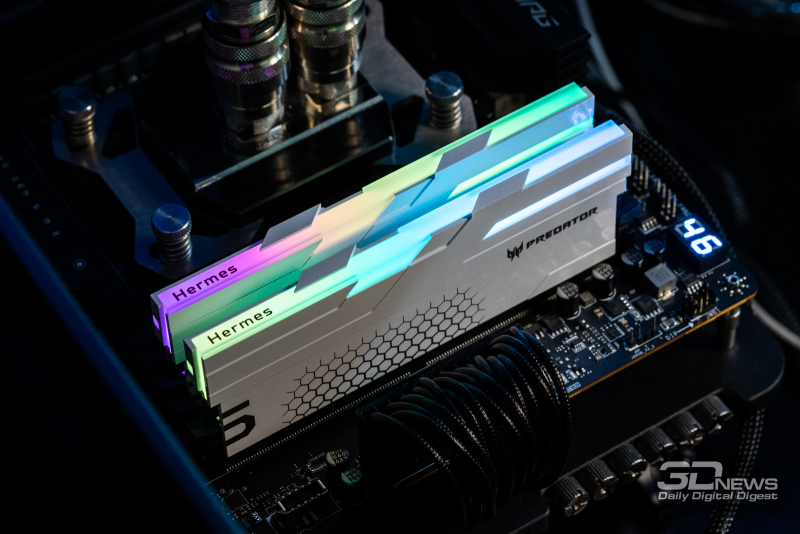
In other words, if you are looking for a memory kit with increased capacity, then the Acer Predator Hermes RGB DDR5-6400 2×32 GB is a very decent, although not cheap, option. However, as practice shows, sets with a total capacity of 64 GB are rarely needed. Despite the dual-rank nature of their modules, which increases the parallelism of the memory subsystem, they provide almost no real performance advantage. In applications, the increase in performance is limited to 1%, and in games it does not go beyond 2%. Therefore, it makes sense to purchase memory of such a volume solely for the sake of specific professional tasks that do not fit into 32 GB. Ordinary users encounter such tasks extremely rarely, although they certainly occur in a professional environment. This means that the considered kit is a purely niche product, the appropriate place for which is not a home gaming PC, but a workstation.